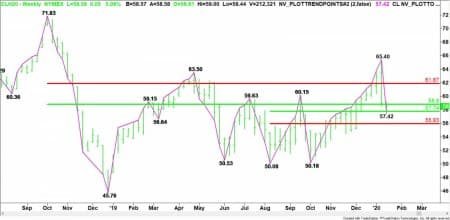U.S. West Texas Intermediate crude oil futures are edging higher on Friday, grinding out a small gain for a third session out of four. Despite what looks like to be a counter-trend bottoming process, the market is still trading lower for the week. However, it’s in a position to turn higher for the week if it continues to strengthen throughout the session.
While some support is being generated from the signing of the U.S.-China trade deal, the OPEC+ production cuts and a bigger than expected weekly inventory draw, perhaps keeping a lid on prices is a report from the International Energy Agency (IEA) that said it expected oil production to outstrip demand.
In addition to the fundamental developments, technical factors are also contributing to this week’s recovery with the market finding support following a test of a key 50% level on the daily chart.
This week, numerous factors contributed to the sluggish price action. There was no particular theme in the data releases, which leads us to believe prices will remain rangebound over the near-term.
American Petroleum Institute Weekly Inventories Report
The API reported on Tuesday a surprise crude oil inventory build of 1.1 million barrels for the week-ending January 10. Analysts were looking for a 474,000-barrel draw in inventory.
The API also reported another build of 3.2 million barrels of gasoline for the week-ending January 10 after last week’s large 6.7-million-barrel build. Analysts were…
U.S. West Texas Intermediate crude oil futures are edging higher on Friday, grinding out a small gain for a third session out of four. Despite what looks like to be a counter-trend bottoming process, the market is still trading lower for the week. However, it’s in a position to turn higher for the week if it continues to strengthen throughout the session.
While some support is being generated from the signing of the U.S.-China trade deal, the OPEC+ production cuts and a bigger than expected weekly inventory draw, perhaps keeping a lid on prices is a report from the International Energy Agency (IEA) that said it expected oil production to outstrip demand.
In addition to the fundamental developments, technical factors are also contributing to this week’s recovery with the market finding support following a test of a key 50% level on the daily chart.
This week, numerous factors contributed to the sluggish price action. There was no particular theme in the data releases, which leads us to believe prices will remain rangebound over the near-term.
American Petroleum Institute Weekly Inventories Report
The API reported on Tuesday a surprise crude oil inventory build of 1.1 million barrels for the week-ending January 10. Analysts were looking for a 474,000-barrel draw in inventory.
The API also reported another build of 3.2 million barrels of gasoline for the week-ending January 10 after last week’s large 6.7-million-barrel build. Analysts were predicting a 3.386-million barrel build for the week.
Distillates also saw inventories increase by 6.8 million barrels for the week. Cushing inventories saw no change.
Phase One Trade Deal
Under the Phase One trade deal, China committed to buy over $50 billion more of U.S. crude oil, liquefied natural gas and other energy products over two years.
Easing of Middle East Tensions
With prices returning to their early December levels, we could see more rangebound trading now that the trade deal is in the books and there has been a de-escalation of tensions between the United States and Iran.
EIA Reports Much Bigger Than Expected Inventories Draw
On Wednesday, the U.S. Energy Information Administration (EIA) reported that oil inventories fell by 2.5 million barrels during the week-ending January 10. Traders were looking for a draw of 500,000 barrels. Inventory now stands at 428.5 million barrels.
Despite the larger than estimated draw, the report was perceived as bearish because of a huge build in products. U.S. gasoline stocks rose by 6.7 million barrels in the week to 258.3 million barrels, the EIA said, compared with analysts’ expectations in a Reuters poll for a 3.4 million-barrel rise.
Distillate stockpiles rose by 8.2 million barrels in the week to 147.2 million barrels, versus expectations for a 1.2 million-barrel rise, the EIA data showed.
Finally, crude stocks at the Cushing, Oklahoma futures delivery hub rose by 342,000 barrels in the last week, the EIA said.
IEA Sees Abundant Global Stocks
On Thursday, the International Energy Agency offered a bearish view of the oil market outlook for 2020.
OPEC supply will exceed demand for its crude, the IEA forecast, even if OPEC member states comply fully with output cuts agreed with Russia and other producers in a grouping known as OPEC+.
OPEC also thinks that supply will exceed demand because of increasing non-OPEC supply growth.
Gains Capped by Sluggish China Economic Data
On Friday, China, the world’s biggest crude importer, raised concerns about fuel demand when an economic report confirmed sluggish economic growth.
The world’s second-largest economy grew by 6.1% in 2019, its slowest expansion in 29 years, government data showed on Friday.
Strong Refinery Throughput Offset Concerns About Sluggish Chinese Demand
Surging Chinese demand as seen in refinery throughput figures offset the less positive economic growth data.
In 2019, Chinese refineries processed 651.98 million tonnes of crude oil, equal to a record-high 13.04 million barrels per day, and up 7.6% from 2018, government data showed. Throughput also set a monthly record for December.
Technical Analysis
Weekly March West Texas Intermediate Crude Oil Technical Analysis

Weekly Trend indicator
The main trend is up according to the weekly swing chart. A trade through $65.40 will signal a resumption of the uptrend. The main trend will change to down on a move through the last main bottom at $50.08.
The main range is $71.83 to $45.76. Its 50% to 61.8% retracement zone at $58.80 to $61.87 is resistance. It is also controlling the longer-term direction of the market.
The minor range is $50.18 to $65.40. Its retracement zone at $57.74 to $55.93 is support. This zone stopped the selling this week at $57.42.
Weekly Trend Indicator Forecast
Based on this week’s price action, the direction of the March WTI crude oil market the week-ending January 24 will be determined by trader reaction to the main 50% level at $58.80.
Bullish Scenario
A sustained move over $58.80 will indicate the presence of buyers. If this move creates enough upside momentum then look for the rally to possibly extend into $61.41.
Bearish Scenario
A sustained move under $58.80 will signal the presence of sellers. This could lead to a retest of the short-term 50% level at $57.74, followed closely by $57.42.
Taking out $57.42 will indicate the selling is getting stronger. This could trigger an extension of the selling into $55.93.

















